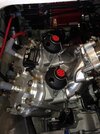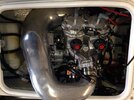Highmaster2
Active Member
Hi,
Have a 2001 SeaDoo GTX Carb Version (951). Started 2001 season with a new top end - standard bore. Also added:
An ADA Billet Head (155psi Domes)
Carbon Tech Super Stock Reeds (206SS)
Proks w/Outerwears
Removed Accel pump and rejetted for that and the Proks.
Ran smooth right up until end of season - started running a little rough but, since it was end of season I just pulled it out of the water. Winterized it and let it sit 'til now.
Now prepping for new season. One of the first things I did was re-torque the ADA head and check compression. Last year my gauge showed 150 psi on each cylinder. Considering the 155 psi domes and the variations in compression gauges I was happy with that.
I charged the battery and also attached a 12 volt jump box to the battery. I checked PTO cylinder first and it showed 150 psi. I then checked the MAG cylinder and it showed 180 psi. I first assume that there is something in the combustion chamber so I pulled the head. Both the head and the pistons looked brand new. I then reinstalled and re-torqued the head and checked the compression again. Still showed 150 & 180. This time the RAVEs were both out. Definitely more pressure escaping through the MAG RAVE slot than from the PTO slot.
Each of the pistons comes up just short of the top of the cylinder before starting back down. I remove the domes and thoroughly clean all the surfaces where the domes meet the head. I then replace the o-rings and reinstall the head. Still showing 150 & 180.
I remove the head and swap the domes. Reinstall the head. Still showing 180 on the MAG cylinder.
I'm stumped. Anybody ever seen anything like this? Not sure what to try next.
Any insight or assistance would be greatly appreciated.
Thanks!
Have a 2001 SeaDoo GTX Carb Version (951). Started 2001 season with a new top end - standard bore. Also added:
An ADA Billet Head (155psi Domes)
Carbon Tech Super Stock Reeds (206SS)
Proks w/Outerwears
Removed Accel pump and rejetted for that and the Proks.
Ran smooth right up until end of season - started running a little rough but, since it was end of season I just pulled it out of the water. Winterized it and let it sit 'til now.
Now prepping for new season. One of the first things I did was re-torque the ADA head and check compression. Last year my gauge showed 150 psi on each cylinder. Considering the 155 psi domes and the variations in compression gauges I was happy with that.
I charged the battery and also attached a 12 volt jump box to the battery. I checked PTO cylinder first and it showed 150 psi. I then checked the MAG cylinder and it showed 180 psi. I first assume that there is something in the combustion chamber so I pulled the head. Both the head and the pistons looked brand new. I then reinstalled and re-torqued the head and checked the compression again. Still showed 150 & 180. This time the RAVEs were both out. Definitely more pressure escaping through the MAG RAVE slot than from the PTO slot.
Each of the pistons comes up just short of the top of the cylinder before starting back down. I remove the domes and thoroughly clean all the surfaces where the domes meet the head. I then replace the o-rings and reinstall the head. Still showing 150 & 180.
I remove the head and swap the domes. Reinstall the head. Still showing 180 on the MAG cylinder.
I'm stumped. Anybody ever seen anything like this? Not sure what to try next.
Any insight or assistance would be greatly appreciated.
Thanks!





